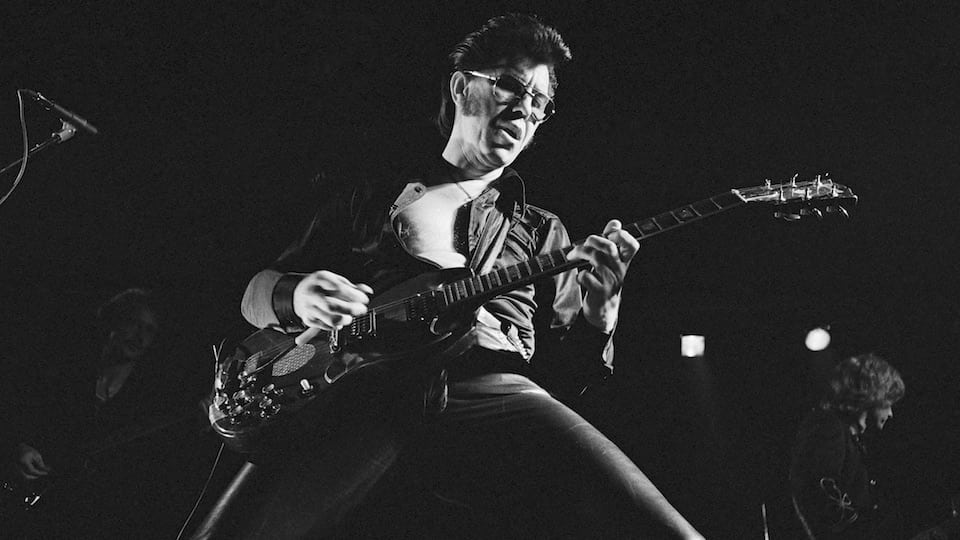Before computers could manufacture any sound a musician heard in his head, artists had to create a figurative (and literal) buzz by slashing, crashing, and damaging the tools of their trade.
For example: Link and the Wray Men were rocking out at a Fredericksburg, VA gig when a DJ asked them to play The Diamonds’ “The Stroll,” a song not in Wray’s repertoire. Fred Lincoln (Link) Wray’s drummer brother, Doug, pounded his kit using the wrong ends of his sticks. Link then grabbed his vocal microphone and placed it in front of his guitar amp, producing a growling sound that he said made the “kids just go ape.” The future godfather of metal knew he was onto something good when the crowd started chanting: “Play that weird song! Play that weird song!”
But when he got to the studio, Link couldn’t recreate the weirdness. As he noted to Guitar magazine: “When we went to record it, I didn’t get that live sound like I did in Fredericksburg. So I got a pen and started punching holes in the tweeters. I didn’t mess with the big speaker. So I started playing and got that distorted sound, plus I had a tremolo. I used a combination of that at the end.” The weird song was later christened “Rumble” by Link’s record label owner’s daughter because she felt its dangerous sound elicited images of a street brawl between two gangs.
The 1958 tune, which Bob Dylan called the “greatest instrumental ever,” was banned from radio in many markets. Even label president, Archie Bleyer, wasn’t a fan, noting: “I never liked Link Wray and the negative influence his music had on the young people of America.”
Link wasn’t the only rocker who took a successful stab at fame and glory. Guitarist Dave Davies used a razor blade to cut one of the greatest rock records ever, the Kinks’ “You Really Got Me.” Dave recalled: “My childhood sweetheart Sue got pregnant and we wanted to get married. But our parents said we were too young and they split us up. I was a rebellious, angry kid anyway, but that had a profound effect on me. I was full of rage. A little later, I was very depressed and fooling around with a razor blade. I could easily have slashed my wrists, but I had a little green amplifier, an Elpico, that was sounding crap. I thought, ‘I’ll teach it’ and slashed the speaker cone. It changed the sound of my guitar. Then, when I wired that amp up to another, a Vox AC30, it made it a lot, lot louder.”
The Standells’ guitarist, Tony Valentino, also mismanaged his anger and inadvertently made a new sound for his band. He stated: “I was so mad that all my friends had Fender guitars and amps and all I had was this cheesy Silvertone guitar and a cheap Sears amp. So, one day, I was particularly frustrated, so much so that I kicked the face of that Sears amp in and the speaker busted in, leaving me with this weird buzzing sound, unlike anything I’d ever heard. I didn’t know it then, but I helped create the distorted sound of punk-rock guitar.”
A broke-down piece of equipment used on a country record was also responsible for ushering in a new sound that filled the rock ‘n’ roll landscape: the fuzz tone. After Marty Robbins (“El Paso”) recorded “Don’t Worry,” the playback revealed that the mixing desk had a damaged channel which resulted in Grady Martin’s guitar buzzing out a funky, distorted sound. Marty didn’t like the new noise but his producer and Nancy Sinatra sure did.
The recording engineer at the session, Glenn Snoddy, said in a 2013 interview with Vintage Guitar magazine: “Nancy Sinatra came to town and wanted to use that sound, and I had to tell her people that we didn’t have it anymore because the amplifier completely quit. So I had to get busy and conjure some other way to make it happen.” Glenn and WSM radio engineer Revis Virgil Hobbs built a stand-alone device that the Ventures used in their “The 2000 Pound Bee” song that was played by Dan Aykroyd at John Belushi’s memorial service in 1982 at the Cathedral of St. John the Divine; where Aykroyd stated: “We agreed that whichever of us died first the other would play it at the funeral and force everyone to listen to it, loud enough so that nobody could really enjoy it.”
The Hobbs/Snoddy invention got major attention from rock fans and musicians alike when it was predominantly featured in the Stones’ “Satisfaction,” the song that kick-started Keith Richards’ rep as the “Human Riff.”
Yes, the job of a rock musician might be the only profession that if something ever breaks, a voice might slur, “Don’t fix it!”
-Mark Daponte
Photo: Link Wray (Getty)





Did Nancy Sinatra ever record with the new fuzz device? If so, which song? – Thx.